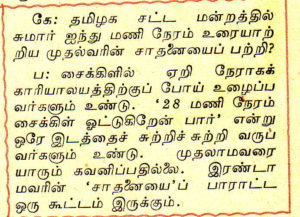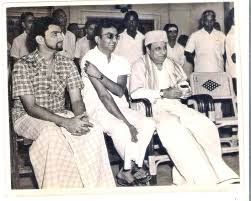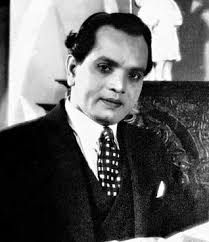Importance of Voice and Inspiration of Raja Sandow
by Sachi Sri Kantha, Feb. 4, 2018
Importance of Voice
Nearby, I provide a question and answer item that appeared in the Thuglak weekly (around 1980 I guess, when MGR was Tamil Nadu’s Chief Minister), edited by drama-movie actor and humorist Cho Ramaswamy (1934-2016). For long, until his death in December 2016, he played the role of Tamil political wiseacre.

Thuglak questions & answers
“Question: What do you think, about the five hour record speech of the Chief Minister?
Answer: There are folks who get on a bicycle and directly goes to office and work. There are others who ride on bicycle for ’28 hours cycling’ and rotate the same location repeatedly. First type is hardly noticed. There will always be a crowd to clap for the ‘record’ of the second type.”
Cho’s answer was witty on surface. The political bite was, MGR was merely repeating the same thoughts ramblingly for five hours and wasting time. Maybe so. But, when one considers the voice recovery MGR made from the life threatening shooting incident in 1967, and in nearly 13 years (at the age of 63) that he could speak at length for 5 hours itself deserves an applause on its own, for MGR’s willpower and voice recovery efforts. Cho wiseacre to ridicule such a recovery without comprehending this truth was rather amateurish.

Cho (with spectacles) & MGR (with white hat)
Unlike recent years when movie stars (few young heroes like Mohan and Prabhu Deva of Kannada origin, villains and many young heroines of Tamil movie industry) don’t care about their voices being dubbed by ‘voice actors’ and do care only about the paycheck received from producers and percentage of profit earnings, MGR was trained in the tradition of treating one’s own voice as his alter image and supreme gift from the God. That MGR was determined to retrieve his ‘damaged’ voice due to gun wound was self-evident, in his few descriptions in the autobiography. Two citations, I provide here.
“After being shot, from the days when my tongue was not cooperating with my will, I had recovered little by little. I do recognize what I speak. But, I also realize that others have better ability than me…I feel ashamed. Why this has to be? For what reasons, it turned out to be? How it could be? Even though I ignore the external circumstances, I’m not blind to my deficiencies. I do observe myself diligently. I do attempt to correct myself…”
In chapter 107 of his autobiography, MGR had described his meeting experience with congenitally blind students. Do remember this episode happened before his 1967 shooting incident. Excerpts translated below.
“For a [Thai] Pongal celebration, I visited the school for the blind, and offered Pongal food to them. Central Minister, Mr. C. Subramaniam, was with me. Many young children were there, some so young, who need to be fed. There were also children aged 10 to 15. The minister’s name and my name were announced as visitors. Then, one of the students asked Mr. C. Subramaniam, ‘Is MGR nearby?’ Then, Mr. C. Subramaniam replied, ‘Yes’. That student responded, ‘Ask him to speak a little.’ Then, I introduced myself as, ‘I’m MGR who have come’. Immediately that student said, “No. No. You are not MGR’.
I was a bit firm. ‘I’m MGR here. Why I should tell a lie?’
That student replied, ‘Your voice is not that of MGR. Your voice had changed.’
I asked, ‘How could you understand the change in my voice? Have you heard my voice previously?’
They also firmly replied, ‘Yes, we have heard.’
I asked, ‘When, in which location?’ They responded, ‘We had seen ‘Nadodi Mannan’ movie. Then.’ [Note by Sachi: As all know, ‘Nadodi Mannan’ (1958) was MGR’s own movie!]
I was surprised. These folks had seen the movie. ‘Excuse me. How did you appreciate the movie?’ I was forced to ask this question, because I wanted to learn something.
Effortlessly, they answered. ‘We could appreciate from your voice. In that movie, your voice was manly and forceful. Now, your voice is somewhat husky and weak.’
Then only I realized. For two to three days, I had spoken at many meetings in Tamil Nadu, and also acted in dramas. As such, I had developed a husky voice then, which I didn’t bother much about. Then only, I realized that these folks could live, by detecting the subtle differences in voice pattern of persons. Therefore, I did tell the truth to them and couldn’t forget them. Not only that, even though they had lost their eye sight, they also offered me a ‘new vision’ to my mind. But, I couldn’t return the favor to them. I also didn’t have the power. Humans should not be satisfied with their external blessings of eye, nose, ear and mouth. They also taught me that human should also be the one who could appropriately use these blessings for their benefit.”
Another interesting episode, MGR had described in his autobiography as a struggling young actor while soliciting opportunities in movies, was his meeting with Tamil movie pioneer, Raja Sandow, This also indirectly affirms MGR’s firm conviction of owning his ‘brand’ of voice. There is hardly any doubt that this vital meeting contributed to MGR’s attributes to movie making, and developing his movie persona.
Inspiration from Raja Sandow

Raja Sandow
Puthukoddai K. Nagalingam (aka, Raja Sandow, 1894-1943) was one of the pioneers of Indian movie industry. A proud Tamilian by birth, he was multi-talented, who first made his mark as a body builder and gymnast in Bombay. Then, made his mark as a silent movie hero in 1920s. Subsequently, Raja Sandow moved to Madras, and worked as a Tamil movie director. It is rather unfortunate that this pioneer received merely a passing mention in one sentence, in the first authoritative book on Indian movies, Indian Film (1963), authored by Erik Barnouw and S. Krishnaswamy. This citation was as follows: “[Associated Films] had been started [in the late 1920s] by a professional strong man, Raja Sandow, who after playing hero roles for Chandulal Shah in Bombay decided to take up production in his native province.” It has been recorded that in silent movies, only the names of the production company and the movie director were credited, but the names of actors were left out. Raja Sandow agitated for recognition of actors in the title credits, and succeeded in his campaign – a paradigm shifting deed for those days!
The mention of Raja Sandow in ‘Indian Film’ was made in association with the introduction of K. Subahmanyam, a Tamil movie pioneer and director (as well as the father of co-author Krishnaswamy), who after building his career as a young criminal lawyer “made side earnings selling stories for silent films to Associated Films”, established by Raja Sandow. This gentleman Subrahmanyam was a benefactor of MGR as well and did receive adequate mention in latter’s autobiography.
Whereas subsequent standard sources on Indian movies (by Narwekar as well as Rajadhyaksha and Willemen) and that on Tamil movies (by Aranthai Narayanan) did provide some information on Raja Sandow, one chapter in MGR’s autobiography offers an interesting detail which have been excluded in these sources, for political correctness. MGR had the courage to record for posterity of what Raja Sandow did in Bombay in 1920s, and how this inspirational deed, inspired himself to incorporate a scene in his successful movie ‘Enga Veetu Pillai’ (1965; Our Own Child). Rather than paraphrasing what he had written, MGR’s story of meeting this legendary Raja Sandow in mid 1930s is worth telling in his own words. Thus, I provide a translation below.
“In a bungalow, in front of the National Movietone, a company named ‘Olympic Pictures’ were arranging to produce a movie. Famous actor Mr. Raja Sandow was supposed to direct that movie. He knows Mr. K.N. R. [Note by Sachi: i.e., Kali N. Ratnam (1897-1950) was MGR’s mentor in the drama company] well. As he had acted previously in the ‘Savukkadi Chandrakantha’ movie, directed by Sandow, [my mentor] had gained this opportunity.
This Raja Sandow didn’t carry the title Sandow, for false prestige. In reality, he was a strong man, and he could use that strength for any reasonable aim, without fear; he was also great in acting. [He’ll] smile, get angry, and cry with hardly any effort. He had the excellent talent to change his facial movements, second by second, like lightning. He was also proud to call himself as a Tamilian, and had the firm belief that ‘a Tamilian shouldn’t bow his head to anyone.’ In those days, Tamilians were ridiculed in north India, as ‘Chaala Madrasi’ [Note by Sachi: a derogatory epithet, literally meaning pimple or blister faced Madrasi, or figuratively meaning scum Madrasi]. As for the movie world, it is not a lie to assert that Mr. Raja Sandow did change this situation, by his deeds.
When he went for a job there, he was ignored. Then, as a trial, he was asked to act in a scene, in which a woman was harassed and carried by three or four ruffians. Raja had to save this woman. He took the opportunity seriously, and attacked the ruffians with his full strength. Those guys got angry and attempted to hit back. That’s all, and Raja took command of the situation, badly mauled all his attackers, and made them run away. (This episode was the inspiration, for the ‘Enga Veetu Pillai’ movie, while introducing the character Ilankovan.) [Note by Sachi: The preceding sentence within parenthesis, appears, as in the original.] Those who got hurt, did complain to the director. Whatever said, [Raja] was offered the role, and became an actor. That in Bombay, more than 35 years ago, a Tamilian became an actor! He became a hero indeed! By his deeds, Mr. Raja showed them that if Tamilians were insulted, then the perpetrators of that deed wouldn’t claim ownership for their teeth! As a result…he became ‘Raja’ for Bombay friends. All had to address him as ‘Raja’. He wouldn’t allow anyone to use ‘Madrasi’ for him to hear. He would insist, that ‘Call others by their names’, and made that happen. It would be tension-filled moments for all who dealt him, akin to having a lion nearby.
[K.N.R.] took me to Raja and solicited an opportunity for me. Mr. Raja was seated in an easy chair. After seeing K.N.R., Raja quipped, “Hey, baldy (It’s been the habit of K.N.R. to keep his head bald), is he your disciple? Is he also a cheerful guy like Chinappa?” [Note by Sachi: This is reference to MGR’s senior P.U. Chinnappa, who was also a native of Puthukoddai town.]
Without answering the question, and smiling, K.N.R. replied, “I had brought him, for soliciting an opportunity in your movie.” Mr. Raja, with his imperious look told me. ‘Uhm! Will you act? I’ll see.’ I looked at K.N.R. He said, ‘Why not act the chain-breaking scene in ‘Manohara’ [drama]?
Immediately, I began…”Aah! Who is that guy, who wouldn’t allow me in?”. and impressed him with a long dialog.
Mr. Raja told me, “Let me see. Act me the crying scene’. Immediately, K.N.R. told me, ‘Pretending Raja Sandow as your mother, you as Manoharan, act that chain-breaking scene, where Manoharan falls in his mother’s feet and cries’.
I began immediately. “Mother! Mother! What did you say now?’ and acted while crying. Then, Mr. Raja patted me in my back. It was indeed a compliment for me. But, I felt that a pat by his strong hand was like a hit by a pestle! That hand packed such a power!
‘Hey Baldy! You had trained your charges so powerfully! Hey – Small boy! (This is how he addressed me.) When you cry, tears should appear immediately! Tears appeared in your eyes, only after you completed two or three sentences. Look here! He said that, and held my leg and delivered ‘Mother! Mother!!’ With his first ‘Mother’ utterance, I noticed that his eyes shed tears.
I’m also one who had experienced in shedding tears in the dramas until then! But, the way he demonstrated then – speaking something else, and immediately uttering the word ’Mother’ and shedding tears instantly, it was disbelief for me then. Now, I could perform like that. But then, I was so tensed, had doubts about my ability to perform.
Mr. K.N.R. told, “Raja! If other boys are in front of you, they will shudder and fumble with words. He acted so strongly. Isn’t that good enough?”
“That’s why I told you, you had really trained your charges diligently.” Then, he looked at me, and asked, ‘Hey Boy! Do you practice body building?’
‘Yes’, I said.
‘I know. When I asked you to cry by holding my leg, the manner you gripped my leg, I felt like you’ll break my leg and cry. What an iron grip?’ he said.
I had such a satisfaction then!. That episode ended like that. But that meeting couldn’t enhance my then life, and the opportunity I was seeking then.”
MGR continued further, by explaining the reasons why he lost to his rival claimants for that movie, Raja Sandow was directing. To quote,
“ ‘Minor Rajamani’ – that was the movie’s name. At the end of the movie, the hero turns into a judge, and father of a child. Then, I was not yet 18; as such, I didn’t have age maturity for that role. Like others, I also realized this fact, But, it hurt me that even though I had impressed Mr. Raja and others with my performance, I lost out…”
A little bit of information on this ‘Minor Rajamani’ movie. It’s story line was based on a novel by Vazuvoor Thuraisami Aiyankar. It was released on November 20, 1937. The cast included, K.T. Sampanki, M.R. Thurairaj, Kothamangalalm Subbu, S. Kamalaveni and P.S. Gnanam, the last two being women. Among the first three men, only multi-talented Kothamangalam Subbu gained recognition and his name is now remembered as an actor in small roles, lyricist, director and author of the popular novel, ‘Thillana Mohanambal’. Performance and contributions of other two actors, K.T. Sampanki and M.R. Thurairaj, are lost to history now; while MGR (despite being a loser then), due to his self-confidence and firm determination to succeed had earned an incomparable stature among Tamils in the past 80 years.
I’m also tempted to provide a brief analysis on why Tamilians were treated badly in Bombay by the north Indians during the days of Raja Sandow. Some may assert that, even now the conditions remain the same. Like everywhere else (either in democratic USA and Britain or in Communist Russia and China), ethnic discrimination based on skin color is a norm in India. Non-enlightened North Indians being light colored do discriminate dark colored South Indians. Thus, it is a given that Tamilians were treated badly in Bombay.
There is another reason, I guess. This may relate to the condition of eunuchs (hijras) living in Bombay. A 1992 brief report in the Lancet medical journal with a caption ‘Begging eunuchs of Bombay’ by Gautam Allabadia and Nilesh Shah, indicated that most of the eunuchs they had contacted “came from Tamil Nadu, but many of the Tamil speakers could speak and understand Hindi.” One is not sure, when this migration of eunuchs to Bombay from Tamil Nadu began. Eunuchs have the cowardly, effeminate image, due to castration ‘on supposedly religious grounds’. As such, any guy from south India was ridiculed by the epithet ‘Chaala Madrasi’. Raja Sandow’s aggression against his north Indian detractors to teach them a lesson can be easily explained from this angle.
Premalata Karupiah, in her latest paper entitled, ‘Voiceless heroines: Use of dubbed voices in Tamil movies’ published last year, makes a passing mention to eunuchs [called Aravanis in Tamil, to transgender folks] by contemporary heroes in Tamil movies: example, Prakash Raj in Appu (2000) and Sarath Kumar in Kanchana (2011) in one paragraph. Not that they were inconsiderate or insensitive to the hapless plight of eunuchs in Tamil society, but we can’t simply imagine either Raja Sandow or MGR portraying an eunuch in any of their movie roles. Raja Sandow and MGR were destined to show the defiant, courageous hero who would ‘usurp the authority to dispense justice and exercise violence’ (as critic M.S.S. Pandian framed) at the slightest provocation to their honor. In his short life span of pre-independent India, Raja Sandow did live that sort of life. MGR, by preference, promoted such a life in his movies, via MGR persona.
Cited Sources
Allahbadia G.N. and Shah, N. Begging eunuchs of Bombay. Lancet, 1992 Jan.4; 339: 48-49.
Eric Barnouw and S. Krishnaswamy: Indian Film, Columbia University Press, New York, 1963, p. 100.
Bhugra, D. Begging eunuchs of Bombay. Lancet, 1992 Feb. 15; 339: 432.
Premalatha Karupiah: Voiceless Heroines: Use of dubbed voices in Tamil movies. Asian Women, 2017 March; 33(1): 73-98.
Aranthai Narayanan: Thamizh Cinemavin Kathai, New Century Book House, 3rd ed., 2008, pp. 31-32, 63-68 (in Tamil).
Sanjit Narwekar (Ed): Directory of Indian Film-Makers and Films, Greenwood Press, Westport, Conn., 1994, p. 250.
M.S.S. Pandian: The Image Trap: M G Ramachandran in Film and Politics, Sage Publications, New Delhi, 1992, p. 43.
Ashish Rajadhyaksha and Paul Willemen: Encyclopedia of Indian Cinema, New Revised ed., Oxford University Press, New Delhi, 1999, p. 205.
MGR: Naan Yean Piranthen, part 2, chapter 76, Kannadhasan Pathippagam, Chennai, 2014, pp. 870-873.
Thanks Dr. Sachi for this wonderful episode on MGR’s formative years. In particular his interaction with blind students moved me to tears. That character of MGR dominated throughout his life leading to donation of most of his property to deaf and dumb people’s facilities. He empathized with common people throughout his life and did whatever under his power to improve their life and that is why his free meal scheme is now enshrined in Indian law.